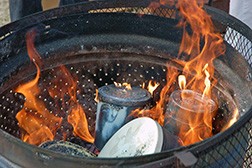Public Growing Program Will Test Effect of Biochar
- Share
- Tweet
- Pin
- Share

Tony Saladino drops a punctured tin full of sawdust into the fire to make more char.
Strike a kitchen match and let it burn halfway down. The blackened end is what is known as char. Inoculate it with a drop of fish emulsion and you have biochar, a substance that biochar advocate Tony Saladino says “can make a poor man feel rich.”
Saladino recently conducted a workshop on making your own biochar at the Greens N Grains Gardens on the grounds of Junction Center Yoga Studio, home of founder Kathy Navis.
Using a five-gallon Cornelius keg stuffed with hardwood sawdust, Saladino built a fire in an old washing machine drum and tossed the Corny keg into the fire. The idea is to heat the sawdust until the gases burn off the wood and pyrolysis – a chemical change caused by heat – occurs, changing the wood into char.
Saladino then “inoculates” the char with compost, fish emulsion and rainwater (or tap water with a small amount of surfactant –dishsoap – added, which reduces the surface tension of tap water and allows the water and char to mix).
Saladino has used many types and shapes of wood in the three years that he has been studying it and using it as a soil additive, and soon learned that sawdust char was the easiest to deal with.
Instead of making your own charred wood, you can purchase gourmet natural hardwood charcoal and use it in the same way as Saladino’s homemade char, however, you have to pound or grind the store-bought charcoal into powder and grains no larger than rice kernels, and Saladino proved that “the grinding down of char into powder is not easy.”
He brought with him several devices he has used to grind char, from a large Hmong mortar and pestle to an old-fashioned clamp-down hand meat grinder. He found all of them have their own challenges, which is why he was happy to find a ready supply of sawdust. He suggested anyone who wants to follow suit find their own supply of sawdust from a local lumber company.
Saladino explained to the workshop participants that when he first applied biochar to one section of his own garden, he saw immediate results, with the biochar section coming up sooner, with thicker, greener leaves, higher yield and longer season than the non-biochar portion of his garden.
USDA researchers in Kentucky made biochar from Kentucky bluegrass and used it as a soil amendment for wheat. The researchers using biochar as a soil amendment increased wheat yield from 26 bushels per acre on untreated soil to 67 bushels per acre on the biochar-treated soil
Saladino also pointed out that expensive equipment is not needed to make biochar. He brought along a bunch of tin containers and a big bag of sawdust. He allowed workshop members to fill the tins with sawdust, poke holes in the tins and drop them into the fire to make their own batch of biochar.
He said char holds six times its own weight in water, which reduces the amount of watering needed for a biochar garden plot.
“I think even small amounts of biochar are helpful,” he said.
University of Wisconsin Agronomy Professor Molly Jahn, one of the keynote speakers at the 2nd annual Climate Change Forum at Stone Harbor Resort in Sturgeon Bay on May 9, said biochar is one of the exciting areas unfolding in soil science.
“There is some very interesting archeology from the Amazon region that suggests that human beings have been building their soil with biochar for a very long time. It’s one of a number of very promising approaches that focus on soil,” she said.
She likens this decade’s focus on soil science to the focus on space in the 1960s.
“It’s an enormously exciting, important frontier,” she said. “The irony is, it’s literally right under our feet, but we know very little about how soil actually works. There’s a lot of debate about what healthy soil is and how to measure it. It is exciting for me to see focusing – as biochar does – on building healthy soil and on recognizing one important place to put carbon is in the soil. Many good things happen, including stabilized productivity and improved water characteristics.”
Kathy Navis intends to conduct a public biochar experiment this summer at Grains N Greens in Egg Harbor by doing side-by-side vegetable plantings in biochar-activated soil and regular soil. The Pulse will be following the experiment through the growing season.
For more information visit the International Biochar Initiative at biochar-international.org.


